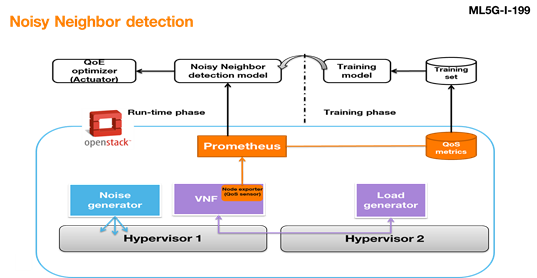 The ITU Focus Group is analysing ML for future networks in order to identify relevant gaps and issues in standardization activities related to this topic – including technical aspects such as use cases, possible requirements, architectures and others. SliceNet is contributing to the standardization of machine learning use cases for the advancement of 5G telecommunications systems.
The ITU Focus Group is analysing ML for future networks in order to identify relevant gaps and issues in standardization activities related to this topic – including technical aspects such as use cases, possible requirements, architectures and others. SliceNet is contributing to the standardization of machine learning use cases for the advancement of 5G telecommunications systems.
The second contribution (ML5G-I-199) made by the SliceNet project and represented by Orange France, proposes a “noisy neighbour” analytical workflow. The workflow determines if a Virtual Network Function (VNF) instance belonging to a slice is being subject to CPU noise coming from another VNF instance collocated into the same physical server or if the VNF is being overloaded due to its internal processes. This model is integrated in Smart City Use Case that implements Intelligent Public Lighting system in the city Alba Iulia, in Romania.
The ML model is used to detect if the perceived Quality of Information (QoI) is degraded due to the noisy neighbour problem or not, as most elements of the network interconnecting the devices will be deployed in a virtualized environment. Since several machines may suffer from this problem in the infrastructure, anomaly detection is needed to run in every machine and an investigation should be tackled in order to determine the root cause of the noise.
The group expressed their interest in the inventories and about the control plane of SliceNet, the interfaces, the APIs, and the vertical feedback. The next step will be to update the contributions in order to express more in details the following topics:
- Defining the vertical input and feedback
- Mapping the vertical feedback to Slice parameters
- Detailing the APIs for data monitoring and actuation via SliceNet control plane
